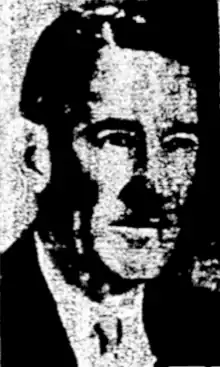Glenn L. Jackson | |
|---|---|
 | |
| Chairman of Oregon State Highway Commission | |
| In office 1959–1979 | |
| Governor | Mark Hatfield, Tom McCall, Robert Straub |
| Personal details | |
| Born | April 27, 1902 Albany, Oregon |
| Died | June 20, 1980 (aged 78) Portland, Oregon |
| Political party | Republican |
| Spouse | Helen Simpson |
| Children | 1 daughter |
| Education | Oregon State University (BS) |
| Military service | |
| Allegiance | |
| Branch/service | United States Army Air Forces |
| Battles/wars | World War II |

Glenn L. Jackson (nickname "Mr. Oregon";[1] April 27, 1902 – June 20, 1980)[2] was a businessman in the U.S. state of Oregon, and an influential transportation planner in the state.[3] He made a strong mark on the state as a 20-year member, and later chair, of the Oregon State Highway Commission, later known as the Oregon Transportation Commission.[3] He was initially appointed to the commission by Governor Mark Hatfield in 1959. He became chair in 1962, and was reappointed by Governors Tom McCall and Robert Straub. Jackson directed the planning and construction of 700 miles of freeway and more than 800 bridges including the Fremont, Astoria–Megler, and Marquam bridges.[3]
Glenn Jackson was born to William L. and Minnie Jackson, in Albany, Oregon on April 27, 1902.[3] His Father came to Oregon in 1877. His Mother was a native of Oregon, born on a donation land claim in Yamhill County, Oregon in 1872. While teaching Mr. and Mrs. Jackson met, both were Linn County, Oregon school teachers. Mr. Jackson was elected superintendent of Linn County schools at the turn of the 20th century. He later became co-publisher of the Albany Democrat-Herald.
Although he was expelled from high school and admitted to Oregon State University on a provisional basis, Jackson received a bachelor of science degree in 1925.[3] After graduating, Jackson started as a salesman for Mountain States Power Company in Albany, Oregon. He became sales manager in 1927 and vice president in 1929. That same year he became vice president and director of California Oregon Power Company (COPCO) in Medford, Oregon. Jackson had a stint in military service in World War II, during which he attained the rank of colonel in the United States Army Air Forces. Jackson served as Executive Officer under Ira C. Eaker, commander of the Eighth Air Force, in Italy. Among the decorations he received were the Bronze Star, Legion of Merit, Order of the British Empire, and Crown of Italy.
After the war, Jackson continued to work for COPCO.[2] He became vice-chairman of the board of Pacific Power & Light (PP&L) (now a division of PacifiCorp) in 1961, when COPCO merged with PP&L, and later chairman, until retiring from that position in 1972.[2] He was also a director of Standard Insurance Company, the U.S. National Bank of Oregon, Fred Meyer, Inc., and the U.S. Chamber of Commerce. He developed White City, an industrial and residential park, on the site of Camp White near Medford, Oregon.[3]
He and his sister inherited a majority share of the Democrat-Herald in 1949. He later bought out the co-publisher and added nine other Oregon weekly newspapers to the company, retaining them until his death in 1980.[3][4]
Jackson was also a trustee of the Agri-Business Council of Oregon, St. Vincent Medical Foundation, Willamette University, Linfield College Board of Associates, Oregon State University Foundation, Rogue Valley Memorial Hospital, Mercy Flights Inc, Rogue Valley Manor, Foundation of Oregon Research & Education, Indian Festival of Arts Inc. and Columbia River Maritime Museum.
Jackson died of cancer at the age of 78 on June 20, 1980, in Portland.[5] The Glenn L. Jackson Memorial Bridge, completed in 1982 to carry Interstate 205 across the Columbia River, is named after him.[6]
Jackson leased, then purchased, in 1946, a fashionable Colonial Revival house in Medford that was designed by noted architect Frank Chamberlain Clark. The house, known as the Clark-Jackson House, is listed on the National Register of Historic Places.[7]
See also
References
- ↑ Leeson, Fred (January 27, 1994). "The Frisbee fix". The Oregonian.
- 1 2 3 Mosey, Ed (June 21, 1980). "Respected entrepreneur: Jackson guided industry, state leaders". The Oregonian, p. A8.
- 1 2 3 4 5 6 7 Mahoney, Barbara: Glenn Jackson in the Oregon Encyclopedia
- ↑ McKay, Floyd J.: "Albany Democrat-Herald". The Oregon Encyclopedia.
- ↑ Bundy, Don (June 21, 1980). "Civic leader Glenn Jackson dies". The Oregonian, p. 1.
- ↑ Federman, Stan (December 12, 1982). "New bridge recalls legendary man, links two states". The Oregonian. p. C7.
- ↑ Kay Atwood (June 1, 1982). "National Register of Historic Places Inventory/Nomination: Clark, Frank Chamberlain, House / Clark-Jackson House". National Park Service. Retrieved November 10, 2016. with 11 photos from 1931 and 1981
External links
- George Edmonston Jr.: Up Close and Personal: “Mr. Oregon”: Glenn L. Jackson, OSU alumni association